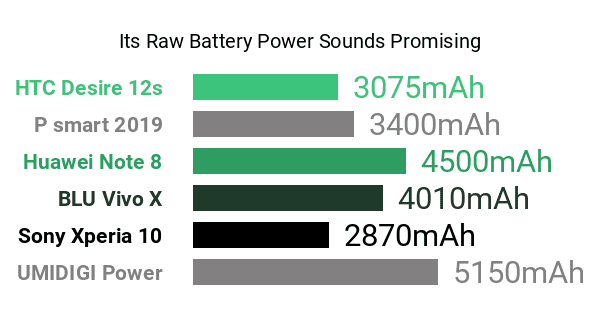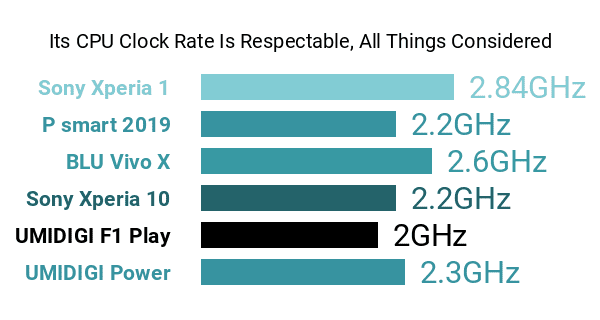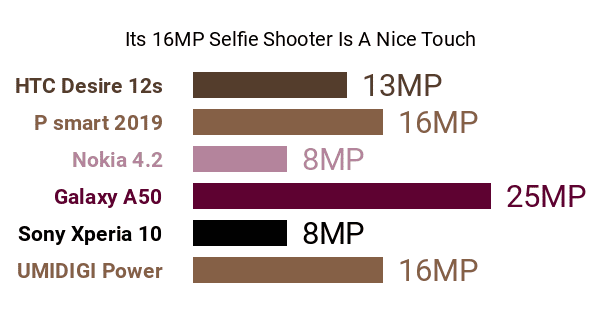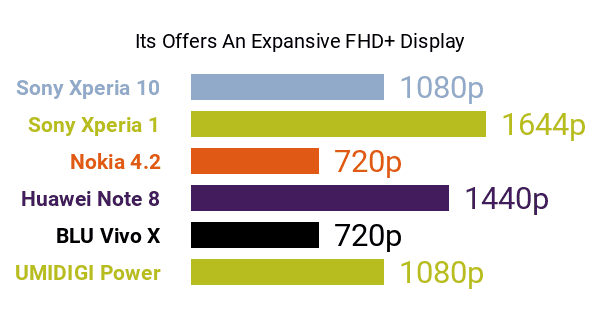- Analysis by KJ David
As given away by its name, the UMIDIGI Power is a 2019-released smartphone banking on a large 5150mAh battery  that resembles those of the leading high-stamina smartphones of its generation, which are featured here on Phonerated. Its stamina-driven pros and cons are led by an 18W fast-charging technology.
that resembles those of the leading high-stamina smartphones of its generation, which are featured here on Phonerated. Its stamina-driven pros and cons are led by an 18W fast-charging technology.

This semi-high-end model still has its fair share of weak points, though, a couple of which are its 4GB-only RAM  and 64GB native storage memory
and 64GB native storage memory  , both of which shudder in comparison to the 6GB RAMs and 128GB storage caps offered by some of its UMIDIGI cousins accordingly.
, both of which shudder in comparison to the 6GB RAMs and 128GB storage caps offered by some of its UMIDIGI cousins accordingly.
Those cons aside, the Power's Helio P35 true-eight-core 2.3GHz processor  sounds like an appreciable pro to us, especially since a lot of its octa-core contemporaries settle for engines that peak at only 2GHz.
sounds like an appreciable pro to us, especially since a lot of its octa-core contemporaries settle for engines that peak at only 2GHz.

Still on its pros, the Power banks on a 16- plus 5-megapixel dual-lens primary camera  that's bedecked with a dual-LED flash and a 6-element lens architecture. It also brings to mind some popular selfie-driven smartphones by touting a 16-megapixel f/2.0-aperture front-facing camera
that's bedecked with a dual-LED flash and a 6-element lens architecture. It also brings to mind some popular selfie-driven smartphones by touting a 16-megapixel f/2.0-aperture front-facing camera  on its screen notch.
on its screen notch.

Speaking of screen, this phone sports a 6.3-inch In-Cell LTPS interface with a wide 19.5:9 aspect ratio  , a 2340 x 1080 Full HD+ resolution, and a decent (as of this specs-based review) 409ppi pixel density count. It comes with a waterdrop notch design and a dedicated reading mode.
, a 2340 x 1080 Full HD+ resolution, and a decent (as of this specs-based review) 409ppi pixel density count. It comes with a waterdrop notch design and a dedicated reading mode.

The rest of its pros and cons include a rear-mounted fingerprint reader, dual 4G VoLTE support (voice over LTE networks), and NFC support. Its is finished in either Black or Gold and it runs on the Android 9.0 Pie platform out of the box.
So, when it's all said and done, the UMIDIGI Power is a middle-class smartphone that primarily caters to battery-cautious shoppers who are inclined to mobile photography.
On-paper Star rating: 
The speed of its MediaTek Helio P35 (12nm) microprocessor (2.3GHz) combined with 8 cores is part of the fastest.
- See also: List of the latest octa-core smartphones
NFC can be used for electronic payments and other applications.
- See also: The latest NFC-enabled phones
It carries the Miracast technology, a system that lets you share your display with a TV
We're dealing with a hefty display here, making it a phablet: 6.3 inches and a resolution of 2340 x 1080 pixels means about 15.1 square inches and an image quality of at least 409 dots per inch (DPI)!
The UMIDIGI Power is not sold with a memory card but it can accept up to 256GB of memory expansion, which will be convenient to save videos and pictures taken with the built-in 16-megapixel (combined with a 5-megapixel sub-cam) camera.
The Power is one of the rare phones to feature a 16-megapixel (combined with a 5-megapixel sub-cam) camera.
If UMIDIGI's claims are accurate, the Power and its (5150mAh) battery will have enough power for 1800 minutes of conversation, a lot of talk time!
The 16-megapixel selfie cam offers an above-average resolution.
It's all well and good that the UMIDIGI Power can record high-resolution 1920 x 1080 movies, but we were disappointed not to find any evidence of the Power featuring an HDMI port (which is convenient to watch HD videos on your shiny HDTV.)
- Recommended alternative: The latest HDMI phone models
It's frustrating that we could not find its weight information.
- Recommended alternative: Photo gallery of the latest slim phones





You Should Also Be Interested In These:
 Full Menu
Full Menu